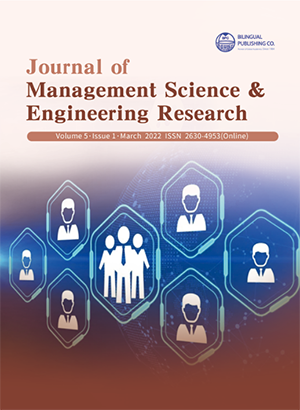-
6189
-
780
-
427
-
427
-
328
Companies and Sustainable Development: The Adequacy of Environmental Impact Assessment for the Management of Environmental Risks
DOI:
https://doi.org/10.30564/jmser.v5i1.4349Abstract
The choice of the environmental risk management instrument to be used within the scope of corporate governance in companies is of paramount importance to avoid or mitigate the triple environmental responsibility to which they are exposed. In this sense, the following research problem arises: The Environmental Impact Assessment (EIA), an instrument of the National Environment Policy and a model of environmental risk management adopted by some companies, proves to be efficient, effective and effective for the fulfillment of the duty to protect the environmental balance and, therefore, for sustainable development? The present study aims to elucidate this research problem. To this end, analyzes were carried out on risk and environmental damage, from a perspective of the socioenvironmental function of companies today; the need for a new posture by companies in view of the reflexes of environmental risks in business activity; and the question of the adequacy or inadequacy of the EIA as an instrument of the National Environment Policy and as a model for managing environmental risks and damages, in the pursuit of sustainable development. The method of approach used was the deductive one, and the research was carried out using the method of bibliographic procedure, through which research was carried out on books, scientific articles and legislation. The result points out the inefficiency and ineffectiveness of the EIA for the management of environmental risks and, thus, for the fulfillment of the duty to protect the environmental balance by companies.
Keywords:
Environmental risk; Governance in companies; Environmental balance by companiesReferences
[1] Messias, E.R., Souza, P.R.P., 2015. Financing and Environmental Damage: The civil liability of financial institutions. Rio de Janeiro: Lumen Juris Publishing Company.
[2] Frade, C., 2009. The law face to risk. Coimbra: Critical Journal of Social Sciences. DOI: https://doi.org/10.4000/rccs.220
[3] Rebelo, F., 2003. Natural hazards and human action: Studies and reflections (2nd ed.). Coimbra: University Publishing Company.
[4] Beck, U., 2011. Risk Society: towards another modernity (2nd ed.). Saint Paul: 34 Publishing Company.
[5] Veyret, Y., 2007. Introduction. In: Veyret, Y. (Org.). The risks: man as aggressor and victim of the environment. Saint Paul: Context Publishing Company. pp. 11-21.
[6] Andrade, R.C., Muniz, M., 2021. Social damages – The revitalization of the civil code regarding civil liability. Saint Paul: Democratic Rights and the Modern State. https://revistas.pucsp.br/index.php/DDEM/ article/view/50109/35521.
[7] Wink, B.I., Bagatini, J., 2020. The civil liability of tobacco companies. Mafra: Profanations. file:///C:/ Users/25461023894/Downloads/1285.pdf.
[8] Brazil, 1981. Law nº 6.938. Brazilia: Government. http://www.planalto.gov.br/ccivil_03/leis/l6938.htm
[9] Fiorillo, C.A.P., 2009. Brazilian environmental law course (10nd ed.). Saint Paul: Saraiva Publishing Company.
[10] Boverio, P.H.F., 2021. The imprescriptibility of the repair of environmental damage from the jurisprudential point of view and the principle of prohibition of deficient protection. Curitiba: Brazilian Journal of Development. file:///C:/Users/25461023894/Downloads/32145-82213-1-PB.pdf.
[11] Milaré, E., 2001. Environmental Law. Doctrine – practice – jurisprudence – glossary (2nd ed.). Saint Paul: Court Journal Publishing Company.
[12] Brazil, 1993. Decree nº 875. Brazilia: Government. http://www.stf.jus.br
[13] Leite, J.R.M., 2012. Environmental damage in the risk society. Saint Paul: Saraiva Publishing Company.
[14] Tucci, C.E.M., Mendes, C.A., 2006. Integrated Environmental Assessment of Hydrographic Basin. Brazilia: Ministry of the Environment.
[15] Messias, E.R., Souza, P.R.P., 2015. Financing and Environmental Damage: The civil liability of financial institutions. Rio de Janeiro: Lumen Juris Publishing Company.
[16] Negreiros, T., 2006. Contract theory: New paradigms (2nd ed.). Rio de Janeiro: Renew Publishing Company.
[17] Messias, E.R., 2017. Introduction to the general principles of Environmental Law (2nd ed.). Curitiba: Editora Prismas.
[18] Souza, P.R.P., 2010. The environmental conflict of sustainable development. Law Magazine Cesumar.https://periodicos.unicesumar.edu.br/index.php/revjuridica/article/view/1534
[19] Leite, J.R.M., Ayala, P.A., 2004. Transdisciplinarity and legal-environmental protection in risk societies: Law, science and participation. In: Leite, J. R. M. & Bello Filho, N. B. (Org.). Contemporary environmental law: pp. 99-125. Barueri: Manole.
[20] Pentinat, S.B., 2014. Analysis of the Contribution of the Sustainable Development Paradigm to Environmental, Economic and Social Justice. In: Caúla, B. Q., Martins, D. B., Mendonça, M. L. C. A. & Carmo, V. M. (Orgs.). Environmental, constitutional and international dialogue: pp. 29-81. Fortaleza: Premius1. http://www.dialogoaci.com/publicacoes/
[21] United Nations Organization, 1992. Declaration of Rio de Janeiro of the United Nations Conference on the Human Environment. http://www.onu.org.br/ rio20/img/2012/01/rio92.pdf
[22] Ortolano, L., Shepherd, A., 1995. Environmental Impact Assessment: Challenges and opportunities. United Kingdom: Impact Assessment. DOI: https://doi.org/10.1080/07349165.1995.9726076
[23] Brazilian Association of State Environmental Entities, 2013. New proposals for environmental licensing in Brazil. Brazilia: Brazilian Association of State Environmental Entities. New proposals for environmental licensing in Brazil. http://pnla. mma.gov.br/publicacoes-diversas?download=73:- novas-propostas-para-o-licenciamento-ambiental-no-brasil&start=60
[24] Hardin, G., 1968. The Tragedy of the Commons. New York: Science Review. 162(3859), 1243-1248.




 Ewerton R. Messias
Ewerton R. Messias





